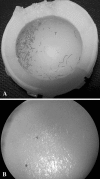Constrained cups appear incapable of meeting the demands of revision THA
- PMID: 22179979
- PMCID: PMC3369098
- DOI: 10.1007/s11999-011-2212-4
Constrained cups appear incapable of meeting the demands of revision THA
Abstract
Background: Failure rates of constrained cups for treating recurrent dislocation in revision THA range from 40% to 100%. Although constrained liners are intended to stabilize the hip by mechanically preventing dislocation, the resulting loss of range of motion may lead to impingement and, ultimately, implant failure.
Questions/purposes: We therefore documented the mechanisms of failure of constrained acetabular cups in revision THA and determined the type and severity of damage (wear, fracture, and impingement) that occurs in situ.
Methods: We retrieved 57 constrained components of four different designs at revision THA and examined for the presence of rim impingement, oxidation, cracks within the liner, backside wear, pitting, scratching, abrasion, burnishing, and the presence of embedded particles. Articular wear was calculated from the volume of the concave articular bearing surface, which was measured using the fluid displacement method.
Results: Failure of the locking ring was responsible for 51% of failures, whereas 28% of revisions were the result of acetabular cup loosening, 6% backside wear, and 22% infection. Impingement damage of the rim of the polyethylene liner was seen in all retrievals with moderate or severe damage in 54%. The average volumetric wear rate of the articular surface was 95 mm(3)/year.
Conclusions: Failure of the locking liner ring and loosening of the acetabular cup are the primary causes of mechanical failure with constrained liners; polyethylene is an inadequate material for restricting motion of the hip to prevent instability. The durability of these devices is unlikely to improve unless the mechanical demands are modified through increased range of motion leading to less frequent rim impingement.
Figures





Similar articles
-
Is Isolated Mobile Component Exchange an Option in the Management of Intraprosthetic Dislocation of a Dual Mobility Cup?Clin Orthop Relat Res. 2020 Feb;478(2):279-287. doi: 10.1097/CORR.0000000000001055. Clin Orthop Relat Res. 2020. PMID: 31794492 Free PMC article.
-
Backside Wear Is Not Dependent on the Acetabular Socket Design in Crosslinked Polyethylene Liners.Clin Orthop Relat Res. 2016 Feb;474(2):374-82. doi: 10.1007/s11999-015-4471-y. Clin Orthop Relat Res. 2016. PMID: 26201422 Free PMC article.
-
Can Dislocation of a Constrained Liner Be Salvaged With Dual-mobility Constructs in Revision THA?Clin Orthop Relat Res. 2018 Feb;476(2):305-312. doi: 10.1007/s11999.0000000000000026. Clin Orthop Relat Res. 2018. PMID: 29529660 Free PMC article.
-
Intra-prosthetic dislocation of dual-mobility cups after total hip arthroplasty: potential causes from a clinical and biomechanical perspective.Int Orthop. 2016 May;40(5):901-6. doi: 10.1007/s00264-015-3000-7. Epub 2015 Oct 1. Int Orthop. 2016. PMID: 26429197 Review.
-
[Research progress of backside wear in acetabular liners].Zhongguo Xiu Fu Chong Jian Wai Ke Za Zhi. 2013 Dec;27(12):1453-6. Zhongguo Xiu Fu Chong Jian Wai Ke Za Zhi. 2013. PMID: 24640364 Review. Chinese.
Cited by
-
Survival Analysis and Failure Modes of Total Hip Arthroplasty Using a Cemented Semi-Retentive Acetabular Cup.J Clin Med. 2023 Dec 5;12(24):7506. doi: 10.3390/jcm12247506. J Clin Med. 2023. PMID: 38137575 Free PMC article.
-
Comparison of Constrained Acetabular Components and Dual Mobility Cups in Revision Total Hip Arthroplasty: A Literature Review.Hip Pelvis. 2020 Jun;32(2):59-69. doi: 10.5371/hp.2020.32.2.59. Epub 2020 Jun 15. Hip Pelvis. 2020. PMID: 32566536 Free PMC article. Review.
-
Backside Wear Analysis of Retrieved Acetabular Liners with a Press-Fit Locking Mechanism in Comparison to Wear Simulation In Vitro.Biomed Res Int. 2016;2016:8687131. doi: 10.1155/2016/8687131. Epub 2016 Sep 19. Biomed Res Int. 2016. PMID: 27722174 Free PMC article.
-
Revision for taper corrosion at the neck-body junction following total hip arthroplasty: pearls and pitfalls.Curr Rev Musculoskelet Med. 2016 Mar;9(1):75-83. doi: 10.1007/s12178-016-9322-2. Curr Rev Musculoskelet Med. 2016. PMID: 26810063 Free PMC article.
-
The unstable total hip arthroplasty.EFORT Open Rev. 2017 Mar 13;1(4):83-88. doi: 10.1302/2058-5241.1.000022. eCollection 2016 Apr. EFORT Open Rev. 2017. PMID: 28461933 Free PMC article. Review.
References
MeSH terms
Substances
LinkOut - more resources
Full Text Sources
Medical

